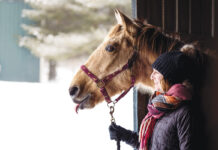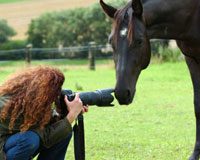Also Read: How to Take Better Selfies with Your Horse?
Get Some Help
A real key to animal photography is to have help. For posed horse portraits (as opposed to pasture shots), I prefer to have two people helping out—one holding the horse, and one behind me or next to me getting the horse’s attention and ears up. Sometimes I can get a horse’s attention and photograph it at the same time by making an interesting noise, but most of the time it’s better to have a second person helping. Simple things like waving a hat or bag or shaking a small bucket of grain can often cause a horse to put on an attractive expression. (Be careful not to go too far and spook your model!)
Choose a Good Background
One of the quickest ways to improve a photo is to utilize what we call a “clean” background. Take a quick look around the edges of your photo before you snap. Is there a horse trailer back there? A corner of the barn? Some fencing that appears to run right through your horse’s ears? Making small adjustments to your position (or your horse’s position) may be all it takes to change a mediocre photo into a good one.
Back Up and Zoom In
One problem I see over and over is that people stand way too close when they photograph their horse’s face. The mistake they make is to use very wide-angle lens (often their phone’s camera) and place it only a couple of feet away from their horse’s face—essentially making the equivalent of an equine “selfie.” The problem is that doing this can introduce quite a bit of distortion into the photo, making the horse’s head seem longer, the ears bigger, and the whole photo rather unflattering (the same thing can actually happen to people with they take selfies!).
So what’s the remedy? Back yourself up a good distance from your horse—ten or fifteen feet or more. Compensate for the distance by zooming in your camera’s lens until your horse’s head fills the frame. If you’re using a DSLR camera for this, try using a focal length of at least 135mm or more; I’ll often try to use 150mm or even 200mm. If you’re using a phone camera or other smaller camera, zoom in as much as you can. This technique will make your horse look much better and much closer to the way he really does. A side benefit is that it makes the background less noticeable.

Avoid the Midday Sun
Photographs of all types benefit from the use of early morning or late afternoon light, as midday sun can cause deep shadows that sometimes aren’t too attractive. This is especially true for horses. A horse’s neck can easily become shadowed by its own head if the sun is high in the sky, so try to avoid lighting like that. Bright overcast days also work well because shadows are eliminated altogether.
How to Take Great Sales Photos of Your Horse >>
Daniel Johnson is a freelance writer and professional photographer.
He’s the author of several books, including How to Raise Horses:
Everything You Need to Know, (Voyageur Press, 2014).See more of Dan’s
horse photography at www.foxhillphoto.com or like his Facebook page: www.facebook.com/foxhillphoto.





